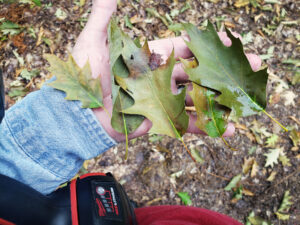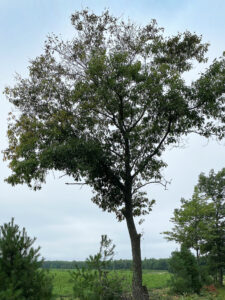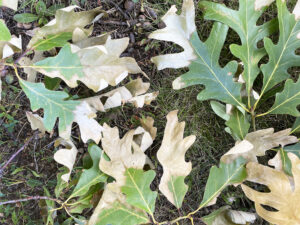By Linda Williams, DNR Forest Health Specialist, Woodruff;
Linda.Williams@wisconsin.gov or 920-360-0665

Oak leaves that drop from a tree infected with oak wilt may be all brown or all green, or often they will have green near the base of the leaf and the outer portions will be brown or watersoaked green. / Photo Credit: Linda Williams, Wisconsin DNR.
The middle of summer is the time to start watching oak trees for symptoms of oak wilt. Although symptoms show up suddenly and leaves drop quickly, symptoms can emerge anytime between now and when leaves turn color in the fall.
Trees that were wounded in the spring and became infected with the fungus that causes oak wilt will usually die that same year. In established oak wilt pockets, the fungus moves underground through grafted root systems and trees will wilt as the fungus moves into the tree.

An oak tree that was infected with oak wilt fungus in the spring starts to drop leaves from the upper portions of the canopy in midsummer. / Photo Credit: Linda Williams, Wisconsin DNR
Leaves will often start to drop from the upper canopy or the outside parts of the branches first, but the symptoms can quickly change to leaves dropping from the entire canopy. Once leaves start dropping from infected trees, most leaves will drop in just 2-4 weeks.
You can find more information on biology and prevention of oak wilt in the Wisconsin Department of Natural Resources (DNR) fact sheet Oak Wilt In Wisconsin’s Forests.
Several management methods are available, but almost all require killing more trees to try to get ahead of the fungus that is being spread underground through the root system. If you would like more information on control options, check out our fact sheet on Oak Wilt Management or contact your local DNR forest health specialist.
Since control will take time and money, it’s best to verify that your tree is actually dying from oak wilt and not something else such as twolined chestnut borer or Armillaria root disease.

Leaves from a white oak tree infected with oak wilt show the typical base of the leaf remaining green while the outer portions are turning brown. / Photo Credit: Linda Williams, Wisconsin DNR
If you suspect oak wilt in forests, you can send photos of the symptoms you are seeing to your local DNR Forest Health specialist so they can determine the likely cause.
If you have a question about yard trees, please contact the Plant Disease Diagnostic Clinic at the University of Wisconsin-Madison for photo submission or sample testing (for a fee), or contact a certified arborist such as those listed on the Wisconsin Arborist Association website.
